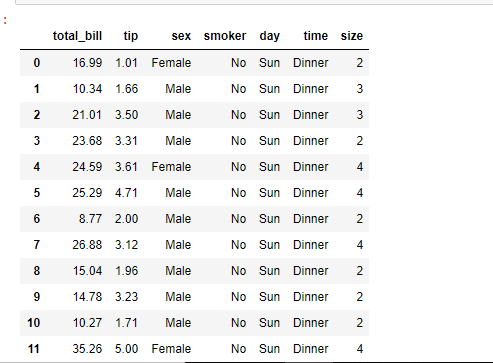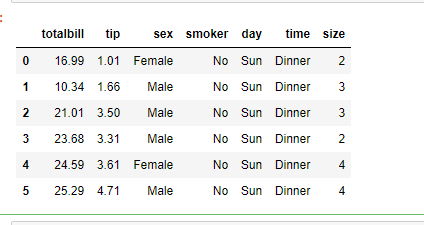如何在Pandas中用自定义分隔符将CSV文件读到Dataframe中
Python是一种做数据分析的好语言,因为以数据为中心的Python包有一个惊人的生态系统。pandas包是其中之一,使导入和分析数据变得如此容易。
在这里,我们将讨论如何将一个csv文件加载到一个Dataframe中。这是用pandas.read_csv()方法完成的。我们必须导入pandas库来使用这个方法。
语法:
pd.read_csv(filepath_or_buffer, sep=', ', delimiter=None, header='infer', names=None, index_col=None, usecols=None, squeeze=False, prefix=None,mangle_dupe_cols=True, dtype=None, engine=None, converters=None, true_values=None, false_values=None, skipinitialspace=False, skiprows=None,nrows=None, na_values=None, keep_default_na=True, na_filter=True, verbose=False, skip_blank_lines=True, parse_dates=False, infer_datetime_format=False,keep_date_col=False, date_parser=None, dayfirst=False, iterator=False, chunksize=None, compression='infer', thousands=None, decimal=b'.', lineterminator=None, quotechar='"', quoting=0, escapechar=None, comment=None, encoding=None, dialect=None, tupleize_cols=None, error_bad_lines=True, warn_bad_lines=True, skipfooter=0, doublequote=True, delim_whitespace=False, low_memory=True, memory_map=False, float_precision=None)
以下是一些有用的参数。
| 参数 | 使用 |
|---|---|
| filepath_or_buffer | 文件的URL或Dir位置 |
| sep | 代表分隔符,默认为csv(逗号分隔值)中的’,’ 。 |
| index_col | 该参数用于将所传递的列作为索引,而不是0、1、2、3…r。 |
| header | 该参数用于将传递的行[int/int list]作为标题。 |
| use_cols | 这个参数只使用传递的col[字符串列表]来制作数据框。 |
| squeeze | 如果是True并且只传递了一列,则返回pandas系列 |
| skiprows | 该参数用于跳过新数据框中已通过的行。 |
| skipfooter | 该参数用于跳过文件底部的行数。 |
这个方法使用逗号’,’作为默认的分隔符,但我们也可以使用自定义的分隔符或正则表达式作为分隔符。
例子1 :使用read_csv()方法,使用默认的分隔符,即逗号(,)。
# Importing pandas library
import pandas as pd
# Using the function to load
# the data of example.csv
# into a Dataframe df
df = pd.read_csv('example1.csv')
# Print the Dataframe
df
输出:

示例2:使用read_csv()方法,用’_’作为自定义分隔符。
# Importing pandas library
import pandas as pd
# Load the data of example.csv
# with '_' as custom delimiter
# into a Dataframe df
df = pd.read_csv('example2.csv',
sep = '_',
engine = 'python')
# Print the Dataframe
df
输出:

注意:在给出自定义指定器时,我们必须指定引擎=’python’,否则我们可能会得到类似下面的警告。

例子3 :使用read_csv()方法,用tab作为自定义分隔符。
# Importing pandas library
import pandas as pd
# Load the data of example.csv
# with tab as custom delimiter
# into a Dataframe df
df = pd.read_csv('example3.csv',
sep = '\t',
engine = 'python')
# Print the Dataframe
df
输出:

示例4 :使用read_csv()方法,用正则表达式作为自定义分隔符。
假设我们有一个带有多种类型定界符的csv文件,如下图所示。
totalbill_tip, sex:smoker, day_time, size
16.99, 1.01:Female|No, Sun, Dinner, 2
10.34, 1.66, Male, No|Sun:Dinner, 3
21.01:3.5_Male, No:Sun, Dinner, 3
23.68, 3.31, Male|No, Sun_Dinner, 2
24.59:3.61, Female_No, Sun, Dinner, 4
25.29, 4.71|Male, No:Sun, Dinner, 4
为了将这些文件加载到数据框架中,我们使用正则表达式作为分隔符。
# Importing pandas library
import pandas as pd
# Load the data of example.csv
# with regular expression as
# custom delimiter into a
# Dataframe df
df = pd.read_csv('example4.csv',
sep = '[:, |_]',
engine = 'python')
# Print the Dataframe
df
输出:

 极客教程
极客教程